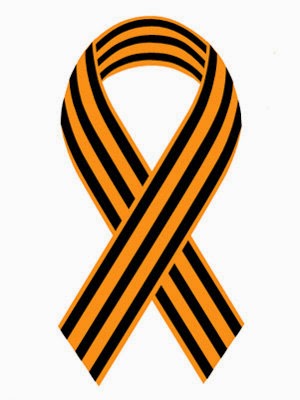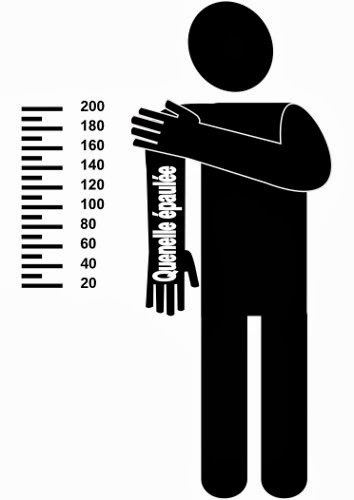The Saker
-------
Reports from Ukraine naturally focus on the horrendous murderous onslaught against the Russian-speaking people in south east Ukraine. Does this mean that all is quiet throughout the rest of the country?
It turns out there is a great deal of sporadic low-level activity against the Ukraine regime. This takes many forms, from peaceful protest to targeted acts of sabotage.

In Odessa, all seems quiet. Many photographs of groups of people displaying the Ukraine flag in oppressions have appeared, with some people wearing the Ukrainian embroidered shirt (Vyshyvka). These include shots of photogenic young women with flowers in their hair. However, the Right Sector symbolism no longer overtly appears. On the other hand, a candle-lit display was held outside the Trades Union building in remembrance of the killed during the false flag operation earlier in May 2014. There are undercurrents of propaganda warfare in which public monuments are painted in a cycle of Ukraine colors followed by Novorossia colors. Interestingly, the Novorossia colors are staying for longer periods of time, suggesting the other side has a reduced capacity to monitor and restore the Ukraine colors. At a more extreme level, branches of Privat Bank have suffered damage from small bombs exploded late at night. This represents an attack on the interests of Kolomoisky, the local oligarch.
In Mariupol, the scene of another attack by Ukraine forces against civilians and police in May, things also seem quiet, but checkpoints still exist on the major roads. Unconfirmed reports suggest the area may be quiet as a result of intimidation from the local right wing groups. Lyashko is reported to have commandeered the house and extensive grounds of a property belonging to Yanukovich. This is located at Uzuf, 20 miles west of Mariupol overlooking the Sea of Azov. This may have been used as the base for training of members of the Azov battalion. Interestingly, a ex-Azov member grew disenchanted with Lyashko, claiming the battalion was used primarily as a vehicle for Lyashko's political ambitions rather than fighting in the south east. There are numerous YouTube videos supporting this, typically showing members rough handling someone or other, described as a separatist supporter, with Lyashko shouting at and intimidating the poor victim. There are more recent reports of guerilla activity against the checkpoints and other targets around Mariupol. Recent reports suggest more concerted attacks are underway. Is this the start of a second front?
Unconfirmed reports suggest that there is a base nearby where US military specialists train Ukrainians in preparation for being sent to Donbass. There have been claims made that a number of these US individuals have been killed by snipers, one whilst bathing on the beach at Mariupol on 30 July and another on 22 August. A video of this last incident was uploaded to YouTube late in the evening of the 22nd, but was quickly removed, possibly within 12 hours and certainly within 24 hours.
Elsewhere, there have been numerous protests by women throughout Ukraine opposing the mobilisation, now in its third phase. The number reported certainly underestimates the actual number of protests, as one only came to notice because a group from OSCE just happened to be in the place the protests was held at the right time. This event was noted on their website. Until recently most evidence for propaganda took the form of the usual pro-Ukraine march, with large banners, people draping themselves in the flag, the Vyshyvka shirt and the photogenic young women with flowers in their hair. This weekend, a large march was held in Kharkiv, with pro-Novorossia supporters doing the same. They had a large 30 m banner with St George stripes, people were draping themselves in St George flags and women wearing St George ribbons in their hair. The demonstration passed of peacefully, with no sign of the Right Sector opposition.

At the other extreme, there have been attempts at tactical sabotage of infrastructure, typically roads and railways. In the most recent case, a convoy of Ukrainian military fuel tankers was destroyed at a place where the road crossed a railway line. This served to sever both communications routes. The attack made use of mines, RPGs an armor piercing bullets, which in turn suggests effective prior surveillance and planning capabilities for the attackers. The attack took place in central Zaporozhye, the oblast immediately west of Donetsk oblast.
The effects of the mobilisation have had a more substantial effect on two specific areas, one (Transcarpathia) within Ukraine and one (Transnistria) adjoining Ukraine.

Transnistria is a narrow land-locked strip of territory between Moldova and Ukraine. It lies to the east of the river Dniester. It was once part of Moldova but following civil war in 1990-2 and a subsequent cease fire, it is now in an unclear legal position. The inhabitants are strongly pro-Russian and have recently asked to join the Russian Federation. Transnistria is not formally recognized by any major state, but does have a Russian troop presence. The European Court of Human Rights considers that the presence of Russian troops gives Russia effective authority over the territory. Russia states that the troops are there to keep the peace and will be withdrawn once a full settlement is reached. Ukraine is busy constructing a large trench, 5 m wide and 2.5 m deep, along the border with Transnistria. This has raised tensions within Transnistria, though in meetings with the US Ambassador to Moldova, they have stressed they are not proposing to attack anyone. Some speculate that Ukraine is raising tensions here in order to provoke a response from Russia. Any Russian military support would have to cross Ukraine territory allowing it to place Russia in the role of aggressor.
Moldova itself is pro-EU. The EU Association agreement will proceed to completion, though this does not imply automatic integration with the EU. Moldova is expected to go ahead with full integration in the near future. There are a number of complicating factors. The main arises from Moldova's complete reliance on gas from Russia, the supply pipelines for which just happen to pass through Transnistria. Transnistria owes about $4 billion to Gazprom for gas supplied, but Moldova is held responsible for the bill. A second complication arises from a desire of another ethnic group's desire to secede from Moldova. Gaugazia seeks to join Transnistria in an attempt to join the Russian Federation.

The second region, Transcarpathia, forms the western most oblast of Ukraine. It borders four other European countries; Poland, Slovakia, Hungary and Romania. It has a very involved political history and a very diverse ethnic composition. The majority speak Ukrainian with a significant minority speaking Hungarian. It is the home of an ethnic group, the Carpathian Rus, whose members spread into south Poland, north Romania and east Slovakia. The terrain is very hilly with steep narrow valleys, making it attractive for tourists.

This area of about 1.2 million people has seen protests against the mobilisation following the deaths in combat of 70 people from the area. The area is also under the control of a regional oligarch, another source of discontent. In the past, Right Sector members have stormed government buildings in the Transcarpathian towns of Berehove and Uzhhorod. The plight of the Hungarians has attracted the attention of the right wing Jobbik party in Hungary who see support for them as a means of gaining votes in Hungary. Representatives of the major Transcarpathian groups have come together announcing their opposition to the Ukrainian regime, and have signed a treaty of mutual assistance and support recently in Yalta. Recently the regional head of the Ukrainian SU has been replaced. A small contingent of Ukrainian military, about 1500 troops and some supporting armored vehicles, has been brought in and stationed near Uzhhorod, a major town close to the border with Slovakia. This seems to be an attempt to clamp down more effectively and to prevent a repeat the events that happened in the south east.
All four countries bordering Transcarpathia have been hit by Russia's reverse sanctions following the imposition of EU sanctions against it. In particular, Hungary has a major trading partner in Russia. Russia is also has a nuclear reactor deal with Hungary to provide it with an alternative energy supply. providing nuclear energy technology. It appears that Hungary would have a strong interest in co-operating with Russia, particularly over the Transcarpathian issue.

Transcarpathia gains additional significance as most of the gas pipelines carrying gas to western Europe pass through it. If Russia was to gain control of this territory, it would then control this choke point on the gas system. This would negate any attempts by the US to gain control of gas flow through Ukraine. This in turn may partly explain Yatsenyuk's haste to sell off Ukraine's pipeline infrastructure. The loss of state control through privatization may in turn have been countered as, in a surprising recent announcement, it seems that Russian interests have acquired ownership of a German company, RWE. This company controls most of the reverse flow pipeline bringing gas back from West Europe into Ukraine.
It seems that all is superficially quiet beyond Novorossia, but this is deceptive and there is scope for dramatic changes. Is the action at Mariupol the start of a second front? Will the events at Kharkiv occur elsewhere? Will the fighting in the south east have the positive benefit of removing fascism from Ukraine? Will a neutral, federated Ukraine arise? Would that be based on existing oblasts or larger ethnic regions? Will Transnistria merge into such a state? Will the curse of the oligarchs be tamed?





